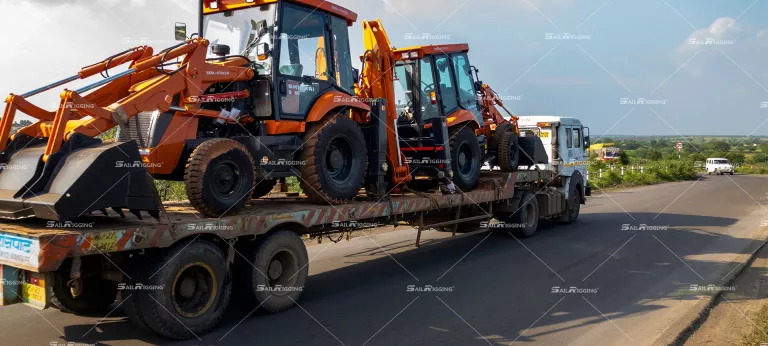Lashing chains, also known as robust cargo lashing chains, are heavy-duty chains used primarily for securing loads in transportation or storage. These chains are essential for ensuring that cargo is safely tied down, preventing movement during transit. With their high strength, durability, and flexibility, lashing chains are widely used in industries such as shipping, construction, and logistics. In this article, we will discuss what lashing chains are, the different grades, end fittings, and other important details.
1. What Are Lashing Chains?
A lashing chain is a strong, flexible chain used to secure cargo and prevent shifting during transportation. Unlike regular chains, lashing chains are designed specifically for load restraint applications. They are commonly used in conjunction with load binders and other accessories to secure freight in trucks, trailers, cargo ships, and containers.
The key purpose of a lashing chain is to provide a secure and stable method of attaching cargo to prevent it from moving, shifting, or becoming unbalanced during transit. Lashing chains are typically made from high-strength materials like carbon steel to withstand the forces encountered during transportation.
2. Grades of Lashing Chain
Lashing chains are manufactured in different grades, each offering varying levels of strength and performance. The grade of a chain refers to its tensile strength, or the maximum load it can safely handle. Common grades of lashing chains include:
- Grade 43 (G43): This is a mid-grade chain offering a good balance of strength and cost-effectiveness. It is commonly used for securing heavy loads in various transportation and storage applications.
- Grade 70 (G70): Known for its high tensile strength, grade 70 lashing chains are used in heavy-duty applications. They are often used in the transportation of goods in trailers, trucks, and other vehicles, where the chain must endure high forces.
- Grade 80 (G80): A premium-grade chain made of alloy steel, offering even higher tensile strength. It is often used in lifting, rigging, and securing applications where superior performance is critical.
- Grade 100 (G100): The highest-strength lashing chain, often made from heat-treated alloy steel. Grade 100 lashing chains are used in critical load restraint and lifting applications where safety is paramount.
3. End Fittings of Lashing Chains
End fittings are essential components that connect the lashing chain to the load, helping to secure the chain in place. The choice of end fitting depends on the specific application, and several different types are available:
- Grab Hooks: These hooks are designed to grab onto an attachment point, such as a tie-down point or anchor. They are commonly used in lashing chains and are suitable for securing large loads. (G43 chain with grab hooks and G70 chain with grab hooks )
- Clevis Hooks: A clevis hook features a pin or bolt for securing the hook to a connection point. These are commonly used in rigging and lifting applications.
- Slip Hooks: This type of hook features a spring-loaded latch that holds the hook in place to prevent accidental detachment from the load.
- S-Hooks: S-hooks are used to secure the end of a lashing chain around a load. The S-shape allows for easy attachment and detachment, making it ideal for quick load restraint.
- D Rings: These are often used as end fittings in more advanced lashing chain systems, providing a secure point for chain connection.
- J Hooks: J hooks R T Hooks are used as chain v bridle tow chain, ensure heavy duty towing more security and durable.
4. Features and Benefits of Lashing Chains
Lashing chains provide several advantages for securing loads in transportation and storage:
- Strength and Durability: Made from high-strength steel, lashing chains can handle heavy loads and extreme forces during transit.
- Flexibility: Lashing chains are more flexible than rigid tie-down straps or cables, allowing them to be used in a variety of applications and to wrap around different load shapes.
- Weather Resistance: Many lashing chains are coated or treated to resist corrosion, making them suitable for outdoor and marine environments.
- Cost-Effectiveness: Lashing chains are generally more affordable than some alternative load restraint solutions, especially when considering their strength and longevity.
5. Safety Considerations
When using lashing chains, safety is a primary concern. Ensure that:
- The correct grade of chain is used for the load being secured.
- End fittings are appropriately rated and in good condition.
- Chains are inspected regularly for wear or damage.
- Proper installation techniques are followed to ensure secure and reliable restraint.
Lashing chains are essential tools for securing loads during transportation and storage. They come in various grades, each suited for different load requirements, and can be equipped with various end fittings for secure attachment. Understanding the proper use and selection of lashing chains ensures safety, efficiency, and reliability in load restraint operations. Whether you’re in shipping, construction, or any industry requiring load security, lashing chains provide a versatile and durable solution. If you have any question, don’t hesitate to contact Sail Rigging.





